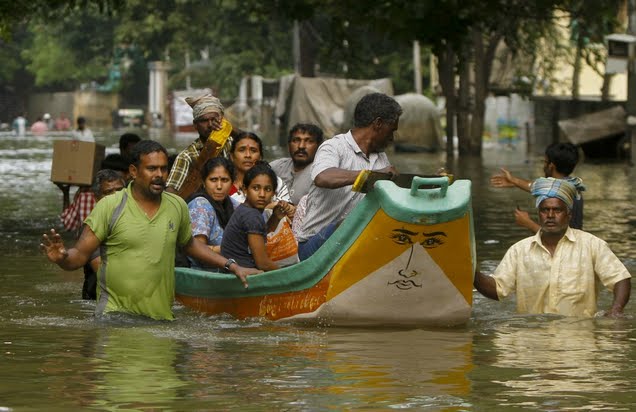 |
| Volunteers rescue flood affected people on a country boat from a residential area in Chennai, India, Thursday, Dec. 3, 2015. AP Photo |
Extreme rainfall in southern India has killed nearly 270 people and displaced about a million more, as flooding causes major problems in the state of Tamil Nadu.
Chennai, the capital of Tamil Nadu and fourth-most-populous city in India, experienced its wettest December day in over a century this week, according to AccuWeather. That follows a November that brought the city 300 percent more rain than is usual for the month. Monsoon winds typically bring rainfall to Chennai during October, November, and December, but rainfall this year has been exceptional — the city and surrounding region has gotten more than 11 inches of rainfall over the last several days, which, as the LA Times reports, is about 75 percent of the average for the whole monsoon season.
"The rain has been abnormal. People have not seen this rain in their lifetime," Jomey Joseph, head of the Chennai office of Catholic Relief Services, told TIME.
 |
| Atul Yadav/ Press Trust of India via AP |
Weather experts have said that this year, a strong El Niño ramped up the monsoon rains in India. And multiple outlets have pointed out that illegal construction and inadequate planning have left Chennai unprepared for deluges like this.
 |
| AP Photo |
Climate change has been shown to make extreme weather events like flooding more likely and more intense, but it's hard to say how much climate change played a role in any one weather event, including India's floods. Still, the news of India's flooding has made it to the Paris climate talks, where world leaders are meeting to hash out an international agreement on climate.
"The unprecedented magnitude of the flooding confirms yet again that we no longer have time. We must take concrete and urgent action against climate disruption," French Foreign Minister Laurent Fabius said.
 |
| AP Photo |
And it's true that, though this current flooding may have been more El Niño-driven than climate-driven, the monsoon rains could be affected as the earth warms. A study last year found that extreme periods of wet and dry weather within Indian monsoon seasons have increased in the last 34 years. Another 2014 study found that Asian monsoons could intensify as temperatures warm and atmospheric carbon dioxide levels climb.
"It's difficult to say for certain that a particular extreme event for the monsoon is attributable to anthropogenic climate change – like the Pakistan floods of 2010 – but we do know that with a warming climate more moisture can be held in the atmosphere, leading to heavier rainfall when it does occur," the Royal Meteorological Society writes. "It is also thought that interannual variability of the monsoon will increase in future, whatever happens to its main driver, El Niño."
World Resources Institute (WRI) India's adaptation strategy head Nambi Appardurai said in a blog post that the flooding in India should be an "eye-opener" for planners in the country.
"While we can't draw a direct connection between events in southern India and climate change, severe flooding is in line with projections of the worst effects of a changing climate and a warmer world," he writes, continuing, "we need world leaders to take action and prepare for mounting impacts of climate change. For some this is abstract; for me and my family, there is literally no time to waste."

No comments :
Post a Comment